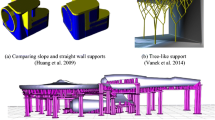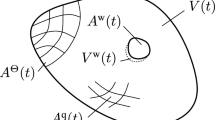Abstract
Simulated annealing (SA) is a general purpose optimization technique capable of finding optimal or near optimal solutions in various applications. The major disadvantage of this technique is its slow convergence making it not suitable for solving many complex optimization problems. This limitation may be alleviated by parallel computing using a multiprocessor computer or a cluster of workstations. In this paper, we present an integer programming model for solving a multi-period cell formation problem in cellular manufacturing system. In order to solve the mathematical model efficiently, we developed a multiple Markov chain simulated annealing algorithm which allows multiple search directions to be traced simultaneously. Our computational results on a single processor machine showed that multiple Markov chain SA is much more efficient than a conventional single Markov chain SA. The parallel implementation of the multiple Markov chain SA further improves its computational efficiency in terms of solution quality and execution time.
Similar content being viewed by others
References
Akturk MS, Turkcan A (2000) Cellular manufacturing system design using a holonistic approach. Int J Prod Res 38:2327–2347
Arkat SMJ, Abbasi B (in press) Applying simulated annealing to cellular manufacturing system design. Int J Adv Manuf Technol
Asokan P, Prabhakaran G, Kumar GS (2001) Machine-cell grouping in cellular manufacturing systems using non-traditional optimisation techniques–a comparative study. Integr Manuf Sys 18:140–147
Azencott R (1992a) Parallel simulated annealing: an overview of basic techniques. In: Azencott R (ed) Simulated annealing: Parallelization techniques. Wiley, New York, pp 25–35
Azencott R (1992b) Sequential simulatd annealing: speed of convergence and acceleration techniques. In: Azencott R (ed) Simulated annealing: Parallelization techniques. Wiley, New York, pp 1–9
Azizi N, Zolfaghari S (2004) Adaptive temperature control for simulated annealing: a comparative study. Comput Oper Res 31:2439–2445
Balakrishnan J, Cheng CH (2005) Dynamic cellular manufacturing under multiperiod planning horizons. J Manuf Technol Manage 16:516–530
Balakrishnan J, Cheng C (2007) Multi-period planning and uncertainty issues in cellular manufacturing: a review and future directions. Eur J Oper Res 177:281–309
Balakrishnan J, Jog PD (1995) Manufacturing cell formation using similarity coefficients and a parallel genetic tsp algorithm: formulation and comparison. Math Comput Model 21(12):61–73
Baxter F (1990) Information technology and global changing science. Conference on global change: Economic issues in agriculture, forestry and natural resources. Washington D.C., 19-21 November 1990
Baykasoglu A, Gindy N (2000) Mocacef 1.0: Capability based approach to form part-machine groups for cellular manufacturing applications. Int J Prod Res 38:1133–1161
Baykasoglu A, Gindy NNZ, Cobb RC (2001) Capability based formulation and solution of multiple objective cell formation problems using simulated annealing. Int Manuf Sys 12:258–274
Cao D, Chen M (2004) Using penalty function and tabu search to solve cell formation problems with fixed cell cost. Comput Oper Res 31:21–37
Caux C, Bruniaux R, Pierreval H (2000) Cell formation with alternative process plans and machine capacity constraints: a new combined approach. Int J Prod Econ 64:179–284
Chaudhry SS, Luo W (2005) Application of genetic algorithms in production and operations management: a review. Int J Prod Res 43:4083–4101
Chen M (1998) A mathematical programming model for system reconfiguration in a dynamic cellular manufacturing environment. Annals Oper Res 74:109–128
Cheng CH, Goh CH, Lee A (1996) Solving the generalized machine assignment problem in group technology. J Oper Res Soc 47:794–802
Chiang TS, Chow Y (1988) On the convergence rate of annealing processes. SIAM J Control Optim 26:1455–1470
Deutsch CV, Wen XH (1998) An improved perturbation mechanism for simulated annealing simulation. Math Geol 30:801–816
Diaz B, Lozano S, Racero J, Guerrero F (2001) Machine cell formation in generalized group technology. Comput Ind Eng 41:227–240
Heragu SS, Chen JR (1998) Optimal solution of cellular manufacturing system design: benders’ decomposition approach. Eur J Oper Res 107:175–192
Jayaswaly S, Adilz G (2004) Efficient algorithm for cell formation with sequence data, machine replications and alternative process routings. Int J Prod Res 42:2419–2433
Kirkpatrick S, Gelatt C, Vecchi M (1983) Optimization by simulated annealing. Science 220:671–680
Kratica J, Tosiæ D, Filipoviæ V, Ljubiæ I (2001) Solving the simple plant location problem by genetic algorithms. RAIRO-Oper Res 35:127–142
Kusiak A (1987) The generalized group technology concept. Int J Prod Res 25:561–569
Lee S-Y, Lee KG (1996) Synchronous and asynchronous parallel simulated annealing with multiple markov chains. IEEE Trans Parallel Distrib Sys 7:903–1007
Mansouri SA, Moattar Husseini SM, Newman ST (2000) A review of the modern approaches to multi-criteria cell design. Int J Prod Res 38:1201–1218
Meise C (1998) On the convergence of parallel simulated annealing. Stoch Process their Appl 76:99–115
Metropolis N, Rosenbluth A, Rosenbluth M, Teller A, Teller E (1953) Equations of state calculations by fast computing machines. J Chem Phys 21:1087–1092
Mungwattana A (2000) Design of cellular manufacturing systems for dynamic and uncertain production requirements with presence of routing flexibility. Ph.D. thesis, Virginia Polytechnic Institute and State University, Blackburg, VA
Onwubolu GC, Mutingi M (2001) A genetic algorithm approach to cellular manufacturing systems. Comput Ind Eng 39:125–144
Plaquin MF, Pierreval H (2000) Cell formation using evolutionary algorithms with certain constraints. Int J Prod Econ 64:267–278
Saidi-Mehrabad N, Safaei N (2006) A new model of dynamic cell formation by a neural approach. Int J Adv Manuf Technol, Online First (DOI 10.1007/s00170-006-0518-2)
Selim HM, Askin RG, Vakharia AJ (1998) Cell formation in groupt technology: review, evaluation and direction for future research. Comput Ind Eng 34:2–30
Singh N (1993) Design of cellular manufacturing systems: an invited review. Eur J Oper Res 69:284–291
Singh N (1996) Systems Approach to Computer-Integrated Design and Manufacturing. Wiley, New York
Sofianopoulou S (1999) Manufacturing cells design with alternative process plans and/or replicate machines. Int J Prod Res 37:707–720
Solimanpur M, Vrat P, Shankar R (2004) A multi-objective genetic algorithm approach to the design of cellular manufacturing systems. Int J Prod Res 42:1419–1441
Su C-T, Hsu C-M (1998) Multi-objective machine-part cell formation through parallel simulated annealing. Int J Prod Res 36:2185–2207
Sule DR (1994) Manufacturing Facilities: Location, Planning, and Design. PWS Publ. Co., Boston, MA
Taboun S, Merchawi N, Ulger T (1998) Part family and machine cell formation in multi-period planning horizons of cellular manufacturing systems. Prod Plan Control 9:561–571
Tavakkoli-Moghaddam R, Aryanezhad MB, Safaei N, Azaron A (2005a) Solving a dynamic cell formation problem using metaheuristics. Appl Math Comput 170:761–780
Tavakkoli-Moghaddam R, Safaei N, Babakhani M (2005b) Solving a dynamic cell formation problem with machine cost and alternative process plan by memetic algorithms. Lect Notes Comput Sci 3777:213–227
Wang TY, Wu KB, Liu YW (2001) A simulated annealing algorithm for facility layout problems under variable demand in cellular manufacturing. Comput Ind 46:181–188
Wemmerlöv U, Hyer NL (1986) Procedures for part-family/machine group identification problem in cellular manufacturing. J Oper Manage 6:125–145
Wemmerlöv U, Johnson DJ (1997) Cellular manufacturing at 46 user plants: implementation experiences and performance improvements. Int J Prod Res 35:29–49
Wicks EM, Reasor RJ (1999) Designing cellular manufacturing systems with dynamic part populations. IIE Trans 31:11–20
Xambre AR, Vilarinho PM (2003) A simulated annealing approach for manufacturing cell formation with multiple identical machines. Eur J Oper Res 151:434–446
Youhua W, Weili Y (1996) Adaptive simulated annealing for the optimal design of electromagnetic devices. IEEE Trans Magn 32:1214–1217
Zhao C, Zhiming W (2000) A genetic algorithm for manufacturing cell formation with multiple routes and multiple objectives. Int J Prod Res 38:385–395
Author information
Authors and Affiliations
Corresponding author
Rights and permissions
About this article
Cite this article
Defersha, F.M., Chen, M. A parallel multiple Markov chain simulated annealing for multi-period manufacturing cell formation problems. Int J Adv Manuf Technol 37, 140–156 (2008). https://doi.org/10.1007/s00170-007-0947-6
Received:
Accepted:
Published:
Issue Date:
DOI: https://doi.org/10.1007/s00170-007-0947-6




